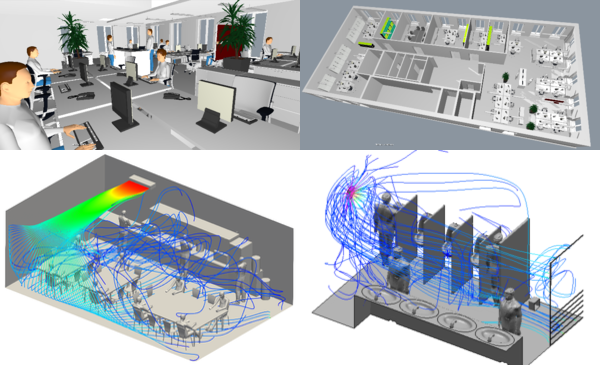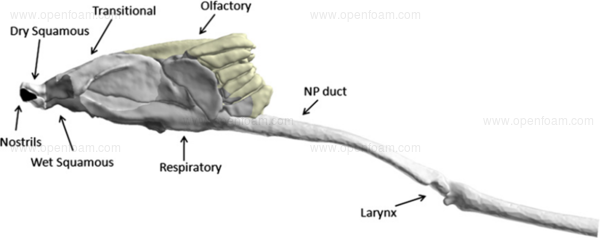OpenFOAM Coronavirus response
OpenFOAM simulations around return-to-office safe distancing demonstrate the effect of occupant proximity, ventilation systems and contamination avoidance unique to each office and plant environment.
OpenCFD awarded Innovate-UK project, Nov'20 - Dec'21
Title: Opensource software simulations towards understanding, monitoring and controlling COVID-19 transmission by managing air, people distancing and adapting urban environments: ventESI
Project number: 85435
Competition: UKRI Ideas to address COVID-19 – Innovate UK de minimis Aug 2020
Ventilation in health care: treatment rooms and theatres
Displacement ventilation in medical treatment rooms and operating theatres are designed to deliver uniform, non-turbulent air to the controlled parts of the room. Nevertheless, zones of dead-air (re-circulations) persist - identifying these is insightful, so that people, equipment or air filters can be placed with safety and wellbeing in mind.
A virtual reality IC.IDO walk-through identifies the stale air regions via "red point-cloud" and "flow vectors". These are the places to avoid, as they are where the ventilation does not directly reach.
Ventilation on an automotive production line
Uniform and adequate ventilation of large halls is a challenge. Ventilation systems are typically designed to protect workers from cumulated exhaust gases or airborne pollutants from the machines and increase occupancy comfort by avoiding high velocities. We can now measure how the efficiently the fresh air reaches the operators and how contamination in the form of aerosol generation from a super-spreader might affect other operators working in their vicinity.
The interactive visualization in Virtual Reality IC.IDO allows intuitive decision-making and interpretation by non-CFD-experts.
Ventilation in office environments
OpenFOAM simulations around return-to-office safe distancing demonstrate the effect of occupant proximity, ventilation systems and contamination avoidance that are unique to each office and plant environment.
This example in an enclosed space demonstrates that the ventilation air-curtain can be protective, or disturbed, by an extreme respiratory event.
This is how customised simulations of your office or assembly plant can help you to;
- design your team's placement so that social distancing rules are observed
- aim the air-conditioning ventilation and fan speed to create air curtains and pockets, to protect against aerosol penetration
- derive rules for local movements and social interaction based on fresh air circulation
- understand how opening and closing doors affects ventilation and air movement
- locate, avoid and clean dead spots where aerosol particulates might linger
- assess open-plan layouts or closed spaces layouts equally easily

Plan your return-to-work
...with our help... contact us
Aerosol and respiration
Recent studies, together with Pacific Northwest National Laboratory, validated OpenFOAM’s aerosol modelling in a nasal/sinus system. We understand the dependence on differing aerosol droplets sizes and effects on deposition on various parts of the respiratory system by carefully studying the effects of varying particle diameters between 1 and 10microns.

OpenFOAM and Supercomputing
We’re making big strides to migrate OpenFOAM towards exascale computing. Several scenarios of proximity, ventilation and safe practices are possible to assess very quickly. This builds essential insights per unique office or plant. Were continuing to work closely with partners at many Tier-0 Supercomputing Centres in Asia, Europe and North America to ensure peak performance and maximal scalability of OpenFOAM.
ESI takes its social responsibilities seriously.
Please stay safe, alert and healthy.














